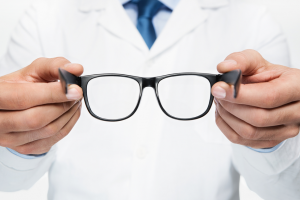
Presbyopia is the medical term for long-sightedness that is associated with age. So what is Presbyopia? Well, it is not a disease, or a condition but more a natural part of the aging process in which the eyes struggle to focus on near objects.
The initial symptoms are problems in changing focus from an object in the distance to a near by object, blurred vision (when viewing close objects), eyestrain after close-up work (especially in dim light) and occasionally double vision and headaches.
At what age does Presbyopia strike?
Presbyopia usually affects people between the ages of 40 and 50. Because it is a slow degenerative symptom, people may go a few years after first noticing the problem and seeking help.
If someone develops presbyopia before the age of 40 then it is referred to as premature presbyopia. Premature presbyopia usually occurs if someone already has hypermetropia (long-sightedness), but it can also occur in people who spend a substantial amount of time involved in close-up work such as reading, sewing or computer work. As ultraviolet exposure can be a factor, those who live in warm climates may be more likely to develop premature presbyopia.

What causes it?
The lens of the eye has to change shape in order to focus on objects of different distances. The natural resting state of the eye allows us to focus on objects in the distance, for this we use long sight. In order for the eye to focus on objects that are closer to us, the lens of the eye must change thickness.
The ciliary muscles of the eye must contract, causing the lens to alter shape. With the lens in a new thicker and more curved shape, the retina is able to bring the light rays from close objects into sharp focus. As we age, the lens of the eye becomes much less elastic and finds it harder to change shape. The ciliary muscles aren’t as strong and supple, and our vision is affected.
What can be done about Presbyopia?
Glasses or contact lenses may be prescribed. If you already wear corrective lenses, then you may find that your prescription has altered and you will need to get a new one. Bifocals or varifocal lenses may be prescribed to allow you to focus on objects that are closer up.
If you wear contact lenses they you may need to start wearing reading glasses too, or to look at different contact lenses such as bifocal or varifocals ones. Your optician can talk you through all of the options, and help you to choose something that works with your lifestyle and budget.

If you do not already wear glasses or contact lenses, then you may need to start wearing glasses for close-up work such as reading. If your optician advises you to wear reading glasses, then it is advisable to ensure that you wear them whenever you do any close-up work to support your eyes and prevent you from having symptoms such as headaches from eye strain. It is also worth being vigilant that you do any close-up work in a well lit environment as poor lighting can cause the symptoms to worsen.
Eyecare Tips
Whether you have no symptoms of presbyopia, the early signs or have noticed a dramatic difference in your near sight due to age; here are some tips to get the best from your vision.
- Visit your optician regularly to maintain the health of your eyes
- Take regular breaks when engaging in close-up work, to allow your ocular muscles to relax. Simply look into the distance every ten minutes or so, to achieve this.
- Wear sunglasses with a high eye protection factor to help prevent UV damage.
- Eat a healthy balanced diet with plenty of vitamins A, C and E.
- If you work on the computer for hours a day, then avoid screen glare by keeping lights from shining directly on to the screen. Keep the screen below eye level and as far from you as possible. Speak to your optician about computer glasses which relieve screen glare and take the pressure off eye muscles.
